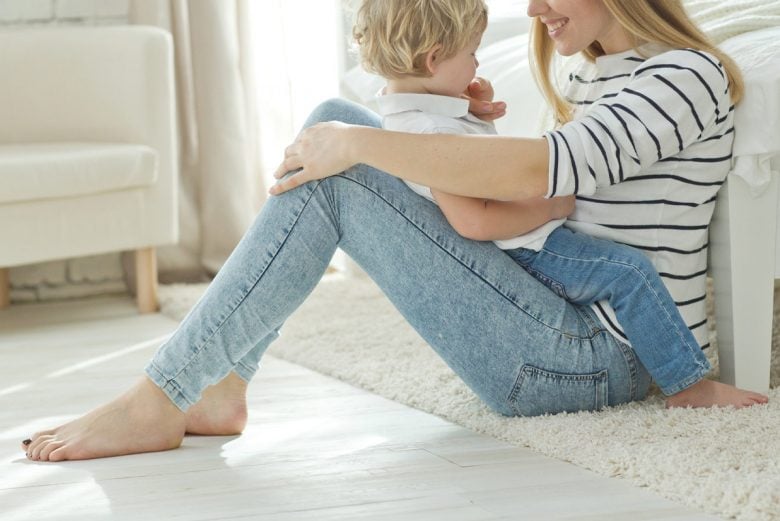
Good communication makes everything easier.
Between 18 months and three years, your child is pushing for new independence. But they don’t always know how to say what they want—which can lead to frustration, for both of you.
In this episode, Carol and Anne share the communication tendencies of all 4 Types of children. Their examples will help you make simple changes so that you and your little one can communicate more easily.
This week’s Parenting Practice
Use your words. Notice times that you can communicate more clearly and invite your children to use words. Use the tips from this episode to give them the words they need. While this week’s practice is specifically directed toward toddlers who are learning to talk, you can also support your older children by communicating positively in the best way for their Type.
Transcript of podcast episode
Carol: That’s what he’s really saying is, “I don’t want any attention. That’s why I kind of left the scene.” So, now you put all this attention on him to try and work it out.
Anne: What’s wrong, buddy? Come back. Yeah.
Carol: They’re like, “Ugh, just leave me alone.” Welcome to The Child Whisperer Podcast. I’m your host, Carol Tuttle, author of the best-selling parenting book, The Child Whisperer. I’m with my co-host, Anne Tuttle Brown.
Anne: We get this question a lot about how to help a toddler learn to communicate. This would be between the age of 18 months to 3 years. Children are learning how to communicate. And we’ll see tendencies amongst each type. And you talk about this in “The Child Whisperer.” Will you review the tendencies for communication for each type of toddler?
Carol: It’s very common for parents to read The Child Whisperer one time and then…
Anne: And change their life, right?
Carol: Yeah. It’s like, yeah, I understand it changed their perception of their child, and yet I wonder in the scenarios that I see posted in The Child Whisperer Facebook group, one of my first thoughts is, “Did they go to the book and read about that particular experience and get help from the book?” Which I would recommend in any situation, if we have information in the book, go to the book.
Anne: Especially, depending on the age of your child, if they’re younger and it’s been six months, a lot can happen in six months. Go back to the book. There may be something that didn’t jump out to you then, that will be timely.
Carol: In recognition of the many, many, many, many parents that do read the book multiple times and then use it as a reference group, I do want to acknowledge that.
Anne: Got to highlight it, dog-ear it.
Carol: It’s very common that that’s happening too.
Anne: Yeah, definitely.
Carol: You’re going to have both camps, you know. Of course, I’m going to turn to the book rather than, “I’m going to post this in the Facebook group and then see what other parents have to say.”
Anne: And it’s kind of like, go to the book and then come with your ideas and you can learn more from other people or their ideas. So, in the book, we’ve got Type 1, they are enthusiastic. Says, “communication is enthusiastic. These kids are chatty, even from a young age, Type 1 children are verbal and motivated by social interaction.” And so, we’ve seen with Type 1 toddlers that they can be early talkers or, you know, even, like, baby talk. They’ll just be making noise.
Carol: They have a lot of animation in the way they phrase things. My little Type 1 grandson, he’s just a real delight to listen to, because he says the most clever things.
Anne: And their voices, their pitch tends to be a little higher, so it’s just so sweet, yeah.
Carol: Rises, lows.
Anne: Does he make up words?
Carol: Uh-huh. Yeah. He’s very Type 1. It’s really interesting to see it in a Type 1 little boy who can be so clever in his speech, in his reference to describing things. And what delights him. We have the story, I may have told this before, but my joke for last Christmas was to give them all underwear because a bunch of boys getting underwear, you know, “Really, Grandma?”
Anne: Thanks, Grandma.
Carol: It was the best gift he got was his Mario, Super Mario underwear. And the enthusiasm that came out of his expression and his language was just so apparent.
Anne: I will say this as a side note. Giving gifts to Type 1’s is so great. My mother-in-law’s a Type 1. You could give her anything and she’s like…
Carol: That’s where the enthusiasm…
Anne: …to the moon.
Carol: …comes over.
Anne: Just so excited. I’m like, I love giving you gifts.
Carol: So, that enthusiasm can play out when they’re frustrated or stressed.
Anne: Yes, that same Type 1 grandson has a very high pitched squeal when he’s frustrated.
Carol: Oh yeah. That little squeal can hit, you know, octaves that are really high and he’s not able to find the words to say, “This is what I need.” So he’s…
Anne: And they have a very quick mind.
Carol: He’ll do it with a very high-squeal pitch…
Anne: Yes.
Carol: …is what you’ll hear in a Type 1 toddler.
Anne: And due to their quickness and their higher movement, they may be frustrated if it’s, like, “I told you what I want and it’s not happening.” Just that quick pace may lend to frustration if they’re not feeling like they’re making sense. And that can be hard when you’re learning words when you’re little.
So, let’s go to Type 2. They have a lower level of movement and it says, “soft-spoken and emotionally aware. They prefer comfortable conversations, may withdraw, worry, or cry if they feel things get too heated, talking through details is enjoyable for them. Because their thought process involves so many details, these children take time telling a story and they often respond slower when asked a question.”
Carol: And they’ll have to pause and think about it too before they put it into language, where a Type 1 can think and speak at the same time. A Type 2 needs to stop, think it through, connect with their feelings, then form their words. And so, if they feel there’s no time for that internal process, they’ll shut down a lot of times.
Anne: Yeah, or quick to tears, feeling overwhelmed.
Carol: Yeah. That’s a way of shutting down, is the tears…
Anne: Yeah, that’s a good point.
Carol: …is just kind of falling into this place of sort of feeling wordless, you know. I can’t.
Anne: And the frustration, we’ve talked about this in the podcast, about whining, would be moaning or a whining or a…
Carol: Right. And in each of these that we’re mentioning the default and the stressful mode, if you respond without coaching them to make another choice when they’re still learning language skills, they’ll start to…that’s reinforced that that’s an option that gets my needs met. High-pitched squealing, whining and tears. See, so, this is where…
Anne: Yeah. So, we’re gonna give you some tips to give them the words.
Carol: Yeah. Because don’t think those…you know, that’s gonna present and that’s an opportunity to say, “Oh, I get to coach my child on how to communicate.”
Anne: And Type 2’s, because of their more thoughtful nature, they can be slower to speak when they’re learning as toddlers.
Type 3 communication, loud and forceful. A Type 3 child’s dynamic nature shows up in their communication patterns. These children express themselves loudly. It’s a more forceful, direct expression that gets right to the point. As babies, they may surprise their parents with how powerful their screams are, that sounds louder than the cries of other children. These children, also they can be early speakers. It kind of can go either way. My daughter, a Type 3, she was a very early speaker. By 18 months, she was saying a lot more words than my Type 2 son was at the same age. And it could go the other way, where they could be like, “I don’t need to know learn the words because I’m getting my point across, and this is just fine,” with a lot of grunts, or if they have an older sibling that’s kind of doing the talking for them, then that could be getting the job done.
Carol: And in a stressful scenario along with getting louder, it could look physical, hitting, punching.
Anne: Throwing things.
Carol: Throwing. Because they’re trying to convey a message.
Anne: And it’s not happening. Yeah.
Carol: And it’s not about they just felt like throwing something right now, and nor is that always motivated by a stressful. Maybe they’re just wanting to interact. They don’t know any other option. So, because they have such a physical connection with the world, hitting, biting, screaming, we do have a podcast episode on all that too. So, you can listen to that one of how to work with those specific hitting, biting, throwing scenarios.
Anne: Time to take a short break. But don’t worry, we’ll be right back after this.
Woman: Knowing your Type and your child’s Type changes everything, doesn’t it? It helps you to understand one another better. It can help your outside, too. When you wear clothes that express your Type, you feel better, you look better, and people understand you more easily—including your kids. Carol Tuttle created the “Dressing Your Truth” program to help you dress true to your Type and create a personal style that expresses who you really are. The best part? You can learn all the basics for free. Start loving how you look and feel at dressingyourtruth.com.
Anne: Okay. Then, we’re moving to Type 4 and their communication is logical and concise. Again, I’m reading this from The Child Whisperer. “Type 4 children value respect, loyalty, straightforwardness in their communications with others. They have a gift for sharing their thoughts clearly and in few words. They hold back until they have something in mind that they are eager to share. And their minds work in a logical accurate way so they express themselves literally.” As a Type 4 toddler learning to speak, they can express that kind of holding back until they feel like they have it perfected in a way, and then speak. I remember I had a cousin who, he didn’t say much until he was 3. And then, it was like a switch turned, and then he could just say… He had, like, seven older brothers and sisters and so he was just hearing speaking all the time, and it was like, he was just working out in his mind, and then one day he just decided, “Okay, I’m ready.” And then it just came out almost perfect. The other tendency you’ll see with Type 4’s is that they’ll repeat a lot. They learn by repetition, by repeating. And this is true for any toddler.
Carol: They’ll repeat what you’re saying.
Anne: Yeah. What would Type 4’s do when they get frustrated, if they’re not feeling heard at this age?
Carol: They shut down and freeze up, or they can just try to control a lot of thing, you know, just get very domineering.
Anne: Or black and white.
Carol: If they don’t feel anyone’s listening to them.
Anne: Just be so frustrated.
Carol: If no one’s listening, they’re going to just try and control the situation to be heard.
Anne: Yeah. A little Type 4 grandson, he’ll just kind of throw himself on the ground, like, it’s over.
Carol: Complete giving up. Yeah.
Anne: Yeah. Black and white.
Carol: It’s very, yeah, like all of a sudden he’s flat out on the ground, and you’re like, “I guess he just quit.”
Anne: Yeah.
Carol: We’re aware you’re upset. Bam.
Anne: Yes. Okay. So, let’s talk about tips.
Carol: Or you know what he does? He’ll go and remove himself and go in a little corner.
Anne: Kind of gather himself or need a minute, a break?
Carol: He just needs to get away…
Anne: He just does that naturally.
Carol: …from everybody. Feels uncomfortable.
Anne: And he’s two-years-old.
Carol: Yeah. He feels uncomfortable where he’ll just go get away, and doesn’t get upset. He’s not making any noise, but he’s just removed and you can tell he’s…he’s not comfortable. And he’s just disconnected. He’s removed himself. Isolated himself.
Anne: Does he engage again when he’s kind of had a moment?
Carol: Yeah.
Anne: Which can be a good practice for a Type 4.
Carol: His dad will say, “He’ll work through it.”
Anne: Yeah.
Carol: “Just leave him alone.”
Anne: Hey, well, that’s great he recognized that.
Carol: Yeah. What he wants is, “don’t put any attention on me.” That’s what he’s really saying is, “I don’t want any attention. That’s why I kind of left the scene.” So, if you try…then now you put all this attention on him to try to work it out.
Anne: What’s wrong, buddy? Come back.
Carol: They’re like, “Ugh, just leave me alone.”
Anne: I have a three-year-old Type 2, and I have just come through this of having to help him learn to communicate. And this was something that weighed heavy on my mind, because I knew as a Type 2, I just naturally felt he would be a little bit later speaker than his sister, a Type 3.
Carol: His sister could step in and speak for him a lot too.
Anne: Mm-hmm. Speak for him. She was a very early speaker and she’s just always making movement with singing, talking. And so, I knew for Sam, my Type 2, I wanted to really put effort into helping him speak because his default was whining, and uh, and a lot of pointing and stuff. And so, helping him to use his words. Daniel Tiger is on a really popular child show, and they have little songs for, like, the lessons they’re teaching. And one is “Use Your Words.” So, we sing that a lot. “Use your words, use your words.” I love that phrase, and I use that a lot of use your words.
Carol: You used it with me on Sunday.
Anne: I did.
Carol: “Use your words, Mom.” I was cleaning the kitchen, and they’re all sitting in the family room, and I said…
Anne: “I guess I’ll just clean this…yeah.”
Carol: “Don’t worry about me. I’ll just clean it myself.” And you said to me…
Anne: Said, “Mom, use your words. What do you need?”
Carol: Yeah. So I said, “I would like you to help me so we can all get this done faster.”
Anne: And we helped. So, that’s the one thing, use your words. And even when Sam was, like, 18-months-old and he didn’t have the words to use, I would use that phrase, I would invite him to use the words, and then I would just use a lot of words to help him. So, he would be “eh eh,” pointing to water. “Sam, would you like water? Say, ‘Mom, can I have some water, please?'” And then, he’d say what he could, mumble it, and I’d say, “Good job.” And by me saying that he’s hearing me say that and I’m just, I was talking so much, just every little thing. “Sam, let’s get your jammies on. Do you want to wear this one? Say, ‘I wanna wear that one, Mom.’ Or are you already done with the bath? Say, ‘Mom, I’m done with the bath now.'” Like, all the time. As many words as I could fit in, just to have him hear the words and learn the words.
Carol: You know, prior to their speaking development, did you use sign language that’s become so popular with really young children?
Anne: You know, Sam didn’t take to that. I would even grab his hands…
Carol: Did Katie?
Anne: Katie did more, yeah. I would be like, “Just say more with your hands.” And he’d just pull his hands away and be like, no.
Carol: So, he didn’t respond to that. It wasn’t he was interested…
Anne: No. I’ve seen some kids do it and they know a lot, and I’m really impressed by that way to communicate. So, if that’s something you’re trying, I think that’s a great way to go.
Carol: It’s important to be mindful though, there’s a point when you want to focus on…
Anne: The words.
Carol: …verbal development.
Anne: Yes, that’s a good point.
Carol: Because they know that option, so there’s a balance in that as well, so make sure you stay on track with, you know, an appropriate timeline for supporting verbal development.
Anne: I even had to catch myself where he would just do the grunt, and I would just respond and be like, “Wait, no. I want to help you learn the words to communicate.”
Carol: Apparently, your dad’s brother, who’s a Type 2, he was known in their family growing up that he would just grunt when he wanted something. So, that’s probably good.
Anne: The youngest of seven kids, you know, you can probably get away with that.
Carol: He wasn’t, though. It was the other one. He had less to…you know. So again, yeah, you want to support verbal development and a lot of adults could, as your story…
Anne: Use your words.
Carol: Yeah. Too often, we’re not using words to just clearly state what we want or what’s important.
Anne: I’m even using this with my 6-year-old, if it’s just positive communication of like, “Mom, get me a drink.” “Let’s try that again, Katie. Can you say, ‘Mom, can you please get me a drink?'” And I’ll wait until she says it.
Carol: Yeah. So, it’s replaying the situation. Let’s let’s reenact that.
Anne: And then, also…
Carol: This is great examples of you coaching and…
Anne: Yes.
Carol: …not expecting your children to just, on their own effort, to be able to employ these choices. You realize, “I have to help…these are skills, and I’m training them.”
Anne: Some days, I was getting annoying because I’m like, “Man, I’m saying so much of the same thing.” But it was like, I just gotta give you more than enough words so you can learn by repeating. And that’s the biggest thing is they’ve got to repeat and it’s like learning a new language. And you know, the more you can talk it, the more you can hear it, the faster you can learn. Also, I would invite my children to have positive communication. So, if they were fighting over a toy, rather than me coming in and saying, “Katie, you need to give that ball.” I would say, “I see two really smart kids, and I see two kids and one toy. You both want the toy. How are you guys going to work this out?” And it would surprise me how they would say…come up with an idea. And I really saw how all my effort paid off the other day when Sam and Katie were playing. They were building a castle out of paper cups. Katie had built the castle out of the cups and Sam came over and knocked it down. And Katie got frustrated, and kind of pushed his hand away. And Sam came up and said, “Katie, next time say, ‘Sam, don’t knock it over,’ and I won’t knock it over.'” And I was like, wow, because I have said that how many times of, like, “Next time, let’s try this. Say this. Can you say that?” And we’ll role play and Katie was like, “Okay.” But, I was so impressed that a 2-year-old had those words to communicate…
Carol: He had the words.
Anne: …rather than saying, “Don’t hit me,” being able to say, “Next time, let’s try this and I’ll respond.” I was…yes. And I did. I prayed a lot. I prayed that he would be able to communicate, but it was very much on the forefront of my mind during this last year, year and a half of helping him develop his communication. And many people comment that he talks very clearly now. He can express himself.
Carol: Yeah, it’s in his life path to be somehow influencing people…
Anne: Because it did. It weighed more heavily…
Carol: …through his communication skills.
Anne: …with him in a unique way than it did with Katie.
Carol: What is this week’s parenting practice, Anne?
Anne: Use your words. You and your children, invite your children to use their words and you use your words to say what you want, and give them the words to speak. Even if…this is specifically directed toward toddlers, learning to speak, but if you have older children, how can you support them in positive communication by using their words?
Carol: Thanks for listening. For more support, go to thechildwhisperer.com, where you can purchase the book, subscribe to our weekly parenting practice email, and find a transcription and audio of “The Child Whisperer Podcast.”
Anne: If you’re listening on iTunes, thank you for leaving a review. If you have a parenting question, please send it to [email protected].



